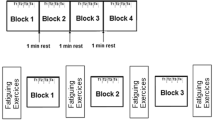Summary
The electromyographic basis of inaccurate performance was investigated in two rapid precision-grip skills controlled by concentric and eccentric muscle contractions respectively. Surface electromyograms, recorded from the first dorsal interosseous (DI), adductor pollicis (AP) and abductor pollicis brevis, were utilised to identify changes in the timing and intensity of muscle activation which may be responsible for inaccurate performance. The results showed that when fast precision-grip skills were controlled by concentric DI and AP muscle contractions, variations in the intensity of muscle contraction were responsible for inaccurate performance. However, when these skills were controlled by eccentric DI and AP muscle contractions, inaccurate performance resulted from variations in the timing of muscle activation. It was concluded that the nature of the deficiency in the patterns of muscle activation resulting in inaccurate performance was dependent upon the type of muscle contraction used in the skill.
Similar content being viewed by others
References
Basmajian JV, DeLuca C (1985) Muscles alive. Williams and Wilkins, Baltimore
Brown JMM, Bronks R (1988) The electromyographic basis of inaccurate motor performance. Eur J Appl Physiol 58:132–140
Close JR, Nickel ED, Todd FN (1960) Motor unit action potential counts. Their significance in isometric and isotonic contractions. J Bone Joint Surg 51-A:1601–1620
Cordo PJ, Rymer WZ (1982) Motor unit activation patterns in lengthening and isometric contractions of hindlimb extensor muscles in the decerebrate cat. J Neurophysiol 47:782–796
Engelhorn R (1983) Agonist and antagonist muscle EMG activity pattern changes with skill acquisition. Res Q 54:315–323
Heckathorne CW, Childress DS (1981) Relationships of the surface electromyogram to the force, length, velocity and contraction rate of the cineplastic human biceps. Am J Phys Med 60:1–19
Jackson KM (1982) Digital analysis of electromyograms — a Fortran package. Electromyogr Clin Neurophysiol 22:65–87
Keele SW (1973) Attention and human performance. Goodyear, Calif
Milner-Brown HS, Stein RB (1975) The relation between surface electromyogram and muscular force. J Phys 246:549–569
Perry J, Bekey GA (1981) EMG-force relationships in skeletal muscle. CRC Rev Biomed Eng December: 1–22
Schmidt RA (1988) Motor control and learning. A behavioural emphasis. Human Kinetics, Champaign, Ill.
Zuniga EN, Truong XT, Simons DG (1970) Effects of skin electrode position on averaged electromyographic potentials. Arch Phys Med Rehabil 51:264–272
Author information
Authors and Affiliations
Rights and permissions
About this article
Cite this article
Brown, J.M.M., Bronks, R. Electromyographic basis of inaccurate movement; its dependence upon the mode of muscle contraction. Europ. J. Appl. Physiol. 62, 162–170 (1991). https://doi.org/10.1007/BF00643736
Accepted:
Issue Date:
DOI: https://doi.org/10.1007/BF00643736




